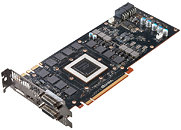Monday, March 18th 2013

NVIDIA Working on Second GK110-based GeForce Graphics Card for Summer
NVIDIA may decisively hold on to the single-GPU performance lead, with its GeForce GTX Titan graphics card, but at roughly $1000, it could attract a very small market. According to a SweClockers report, NVIDIA is looking to woo gamers just ahead of Summer with the second GK110-based GeForce GTX graphics card. Similar in specifications to the fabled Quadro K6000, the new SKU could feature 13 out of 15 streaming multiprocessors on the GK110 silicon, working out to 2,496 CUDA cores, 208 texture memory units, a 320-bit wide GDDR5 memory interface holding 5 GB of memory, and 40 ROPs. Given that there's a deep ravine between the ~$450 GeForce GTX 680 and ~$1000 GTX Titan, NVIDIA could pick a price-point in the middle. The report claims the new SKU could launch some time between July and August, 2013.
Source:
SweClockers

74 Comments on NVIDIA Working on Second GK110-based GeForce Graphics Card for Summer
idk but the review sites should be more harsh about this.
I know businesses are no charity, but people should support amd as they have proven to have better business practices than both nvidia and intel
I agree btw
Back when GTX 280 was released, it cost 500$.
Then, GTX 295 was released half a year later and cost 500$.
Then, GTX 480 was released a year later and cost 500$.
Then, GTX 580 was released half a year later and cost 500$.
Then, GTX 680 was released a year and a half later and cost 500$.
Then, GTX 690 was released a quarter later and cost 1,000$!
Then, GTX Titan was released half a year later and cost 1,000$!
Okay, so the prices don't go down anymore.
Does that mean that GTX 780 will cost 2,000$? GTX 880 will cost 4,000$?
Why are we letting this happen?
You're also missing the GTX 590 ($699. As was the HD 6990), and previously, the nominal MSRP's were:
9800 GX2 $599
8800 Ultra $630
7800 GTX 512MB $650 (as was the X1900 XTX launched a few weeks later)
6800 Ultra Extreme 512MB $899
6800 Ultra Extreme 256MB $549 (as was the X850 XT PE)
FX 5950 Ultra $500 (as was the Radeon 9800 XT)
FX 5900 Ultra $500 (as was the Radeon 9800 PRO)
You notice the trend ? When both camps have broadly equal performance cards available, the price is also held in check. This is the same regardless of vendor. The HD 5970 held sway as the single fastest card from its launch up until the GTX 590 and HD 6990 eventuated. The HD 5970 was nominally a $600 card, and as "top dog" held pricing lower/similar performing cards at lower price points - notably the GTX 480 and GTX 580.
Indirectly, I suppose. I've been an avid hardware buff for more years than I care to remember, and started a fairly comprehensive database of specs, reviews, usage, and evolution of graphics around the time that workstation graphics started becoming interesting for me ( i.e. SGI's IRIS ~1983)...back when information still arrived in a physical mailbox in the form of magazines, trade publications, and books.
An abridged version is presently in the editing stage for publication as a series at another site.
When I see these oddities appear, I wonder what their point is other than dumping salvage.
I keep pondering the possibility of AMD going the RV770 route with Hainan and make not only 1792x2, but 1536x2 cards (remember the 4850x2?). The former would certainly make more sense as a >300w card to take on 690 (greater than 1019mhz and using >6ghz ram would be needed to beat it...in theory AMD could go up to 1111/7000), but the later would make a ton of sense in the 225-300w club. It may not be directly comparable to Titan (even if it is on paper) because of multi-gpu versus single chip issues, but it could certainly battle something like this at a (slightly) more realistic price point and seem appealing.
BTW, it would seem obvious the point of this is to equal absolute performance of 7970 at stock...or roughly 90% of Titan. To put it another way: ~1.5x 7950/660ti/7870XT (Tahiti LE)
Im guessing their setting this up to be the dual gpu one pcb monster.
K20x = GTX Titan $999
K20 = GTX Titan-mini $849-$899
K6000 = GTX Titan-supermini $699-799 due to 3GB memory (Same performance as 7970 GHz)
1. I doubt Nvidia actually want meaningful quantities of single GeForce GK 110 cards sold (since it diverts from Quadro/Tesla), let alone letting them go out two at a time.
2. The HD 7990 that is available at present uses a non-PCI SIG three 8-pin PCI-E power connection. That would also be enough to drive 2 x GK 110 + vRAM, if AMD decided upon not limiting clocks of a reference 7990 and going with the TUL design.
3. The main problem for a dual-GK 110 would likely be physical PCB real estate limitation with the amount of memory chips required. 3GB per GPU would be feasible...I don't think 2 x 6GB would be.
4. If AMD decide to redesign their 7990 into a semblance of a production card (dual slot, 2 x 8-pin PCI-E) then Nvidia would likely see a more aggressively clocked dual GK 104 as a likely competitor.
Personally I doubt that a dual-GPU war is high up on either vendors "must have" list. The R&D versus PR gain becomes increasingly smaller as the second generation of 28nm approaches.
The 7990 and 690 are out there in such limited quantities it isn't funny. The Titan is an even rarer breed. Let's assume you can physically make this card (read: huge assumption).
Your $1000 card is doubled. On top of that, you've got a price premium for all the unique components. I can't see anyone buying a $2000+ card, and I can't see any card manufacturer ever putting something out there that has absolutely no market. Anyone running two Titans obviously has some serious hardware, which would make running a pair in SLI very easy. Even crunchers would have a hard time justifying a single card that has that poor of a cost-benefit ratio.
GTX 680 4GB $539-$599 so I would expect it to cost more.
With 7790 ready to go and the 655 TI around the corner. There bigger brothers shouldnt be too far away making these cards even more overpriced.
7800 GTX 512 - 600$ / X1900XT - 400$ (identical performance to X1900XTX)
8800 GTX - 600$ / HD 2900XT - 400$
8800 Ultra - 700$ / N/A
9800 GX2 - 600$ / HD 3870 - 450$
GTX 280 - 500$ / HD 4870 - 300$
GTX 295 - 500$ / HD 4870X2 - 550$
GTX 480 - 500$ / HD 5870 - 350$
GTX 580 - 500$ / HD 6970 - 350$
GTX 590 - 700$ / HD 6990 - 700$
GTX 680 - 500$ / HD 7970 - 500$
GTX 690 - 1,000$ / HD 7990 - 1,000$
GTX Titan - 1,000$ / N/A
So, as you can see.. with the GTX 590/HD 6990, nVidia and AMD have set a dangerous precedent of pricing Dual-GPU cards above 600$, and nVidia exacerbated this by pricing the GTX 690 at 1,000$. This caused the non-reference HD 7990 to be released at an identical 1,000$.
This means we'll never again have our 500$ GTX 890's, like the GTX 295, and it sucks.
Say its released 2 month from now that would be a $500 premium on a Titan card. Dont see that happening and it will just look bad.
Not saying they have to but I really dont see them justifying selling a GK110 chip for $450-$500 when 2 months earlier your selling it at double the price for 10-15% performance increase.
That just leaves them open for AMD to out clock them with there refresh at a more attractive price point.
GTX 590 - 700$ / HD 6990 - 700$
GTX 680 - 500$ / HD 7970 - 500$ (note: the 7970 was $549 at launch)
GTX 690 - 1,000$ / HD 7990 - 1,000$
GTX Titan - 1,000$ / N/ANot really. These things tend to cyclic. The userbase as a general rule doesn't allow the price to stay at peak levels- it simply isn't pervasive enough. If it was we'd be paying a lot more than $1K for any enthusiast single GPU graphics card. The $500 single GPU card has been around for a few generations, and for some reason people think that the price has always been in vogue. Once upon a time, $280-300 bought a top of the line card- it didn't stop companies jamming some extra goodies onboard and charging a 200% mark-up. You might also note that an SLI solution could cost $1800-2500 scarcely two years later ( Google Quantum3D Obsidian Pro 100DB-4440 or 100SB-4440V for instance), then factor in inflation. You might also note that ATi's All-In-Wonder's progenitors were generally amongst the trendsetters in incrementally raising prices towards (and past) the $500 markin the first place for the volume production high end.
My point was about the GTX 590 and onwards, not the preceding generations. Their only purpose was to build up a case.
But I thought I'd respond anyway.Well, it's my comparison, so yes, in fact.. I do get to choose.Define "marginally". It was no more than a 2% overclock on an "OC" edition card that typically adds 10$ to the stock price. Except this time, it was 200$.. which is why an XTX was a good way to tell whether someone was a hardware enthusiast or not.You can quote links all you like - the MSRP wasn't correct in the 7800 GTX 512's case.Thanks for the history lesson, but I was alive in 2007, as well.Yes, I did.I didn't have room for the HD 5970, because the HD 5000 series was more of an inbetween than a rival, since the GTX 200 series was GPU-for-GPU for powerful and the GTX 400 series was late.
Yes, HD 7970 started at 550$, but when GTX 680 came out the price dropped to 500$.. which is what counts.(I can accept "tend to be cyclic", but "tend to cyclic" simply doesn't sound right.)
Yes, they tend to be. Yes, it is a general rule. That is precisely the issue.
You're missing the point with your lax generalizations. The only reason graphics cards won't cost 2,000$ is because the international over-arching consumer hyperbole of demand cannot extend that far. At a certain point, raising a price on a product with a hard-demand inclination does lower its demand, and no one is going to pay 2,000$ for a graphics card.
This does not mean that we're not already in deep shit. 1,000$ for a graphics card that would have cost 500$ 3 years ago, is ridiculous. The cycle has clearly changed.You're making my point for me. Yes, prices have been going up for some time now. This is bad.Yes, a company that priced its cards at 2,500$ could not compete and now no longer exists.
Miracles do occur.And ATi's All-in-Wonder cards are also extinct.